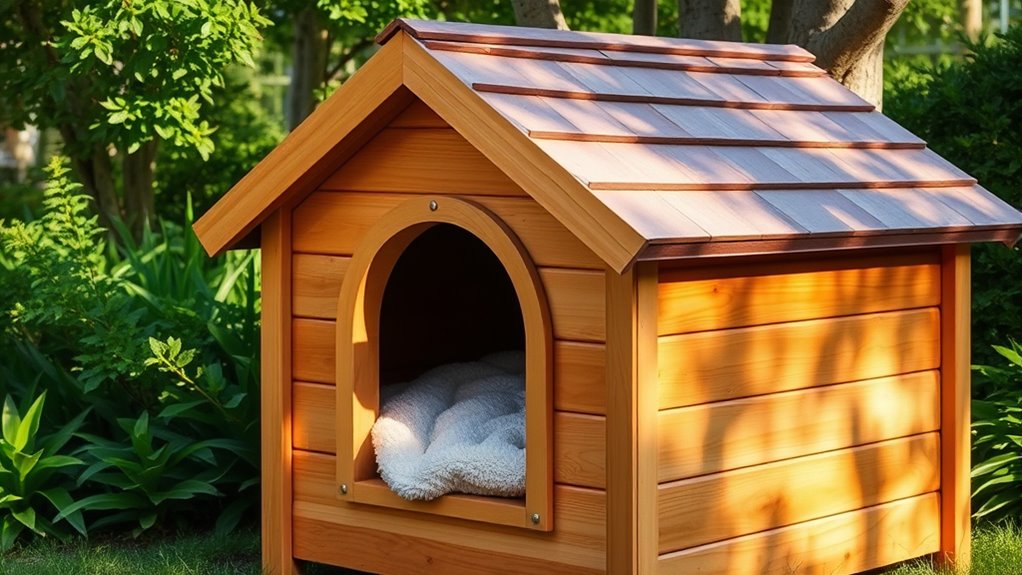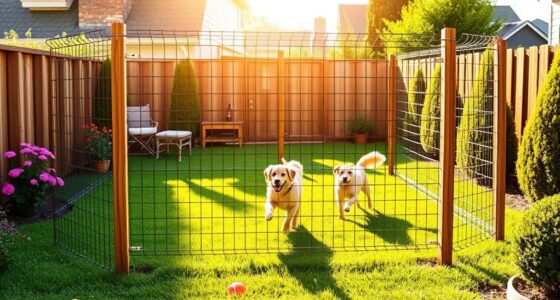To build a cozy outdoor dog house, start by planning the ideal size and design based on your dog’s breed and weather conditions. Gather durable, weather-resistant materials and essential tools. Create a solid foundation on level ground with proper drainage. Build insulated walls and a sloped roof for rain runoff. Add ventilation and weatherproof sealants to keep your pup warm and dry. Keep caring for it regularly, and you’ll create a perfect haven—there’s more to discover below.
Key Takeaways
- Plan the dog house size based on breed, growth, and comfort, ensuring space for standing, turning, and lying down.
- Choose weather-resistant, safe materials and prepare a level, well-drained foundation for durability.
- Build insulated, ventilated walls and a sloped roof with overhang to protect against rain and wind.
- Seal cracks, add weatherstripping, and apply waterproof paint to weatherproof and insulate the shelter.
- Regularly inspect, clean, and maintain the dog house to extend its lifespan and keep your pet comfortable.
Planning Your Dog House Design and Size
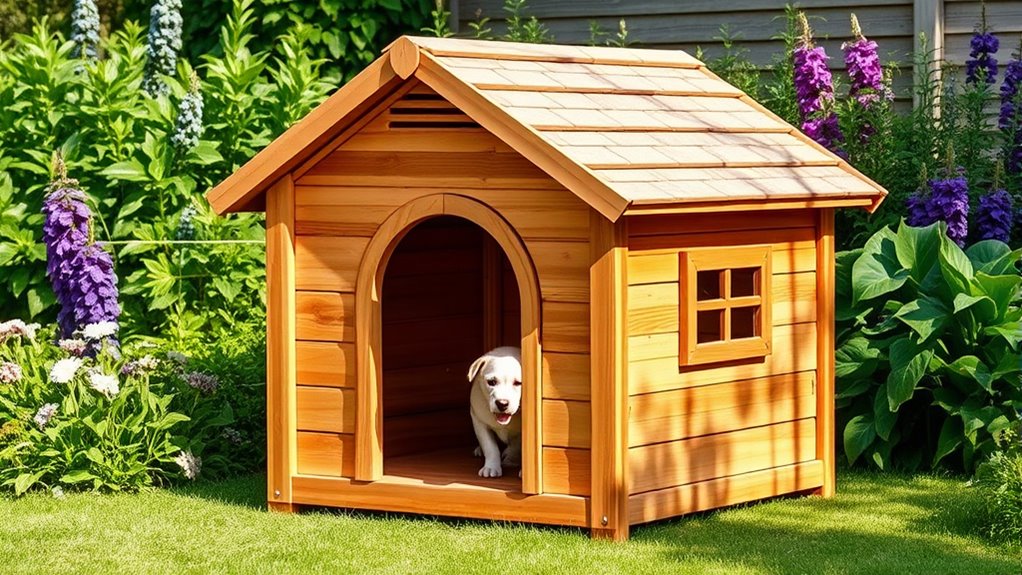
Before building your dog house, it’s essential to carefully plan its design and size to guarantee your pet’s comfort and safety. Start by considering ideal dog house dimensions based on your dog’s breed, size, and growth potential. An outdoor shelter should provide enough space for your dog to stand, turn around, and lie down comfortably. Measure your dog from nose to tail and add a few inches for extra space. Think about the climate and weather conditions, which influence door placement and insulation needs. Proper outdoor shelter planning ensures your dog stays warm, dry, and secure. Remember, a well-sized and thoughtfully designed dog house enhances your pet’s well-being and makes maintenance easier for you. Planning thoroughly now saves headaches later.
Gathering Materials and Tools Needed
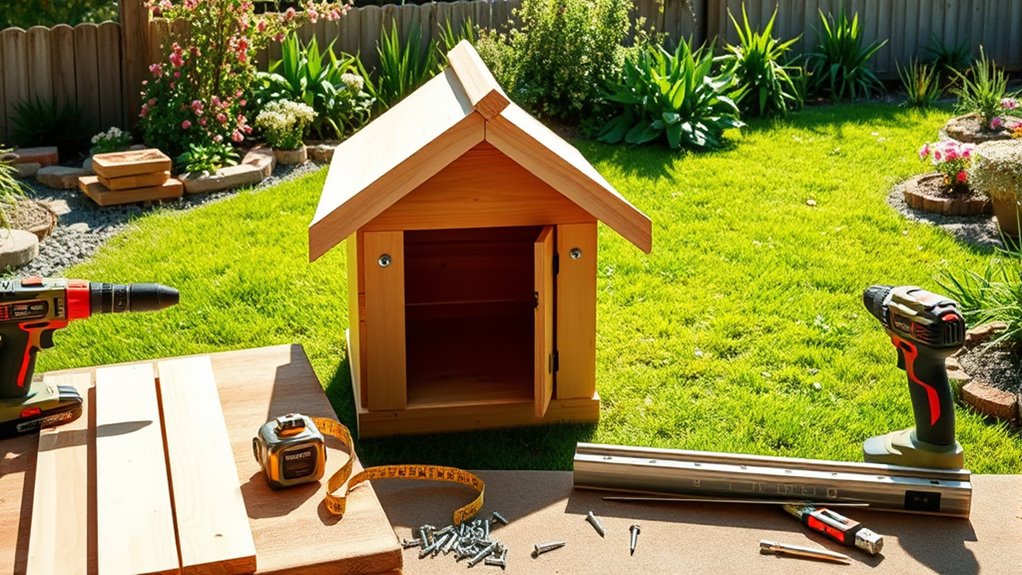
To construct a sturdy and comfortable dog house, you’ll need to gather the right materials and tools first. Start by choosing tools such as a saw, hammer, drill, measuring tape, and level, which will make construction easier and more precise. Gathering materials involves selecting weather-resistant lumber, exterior-grade screws, roofing materials like shingles or waterproof panels, insulation, and paint or sealant for protection. Make sure to get enough lumber for walls, floor, and roof, and consider additional materials like hinges for any doors or windows. Having everything on hand before you start saves time and prevents interruptions. Focus on quality tools and durable materials to ensure your dog’s shelter is safe, long-lasting, and comfortable. Proper preparation makes the building process smoother and more enjoyable. Additionally, understanding the importance of relationships and trust can help you create a space that is not only durable but also safe and welcoming for your pet. When selecting materials, consider choosing dog-friendly and non-toxic options to ensure your pet’s safety and well-being. Incorporating electric tools can increase efficiency and accuracy during construction, especially when working with tough materials. Using detailed plans can also help prevent errors and ensure the structure fits your dog’s needs perfectly. Also, be aware that credit card security measures are essential when purchasing materials online to protect your financial information.
Creating a Solid Foundation for Stability
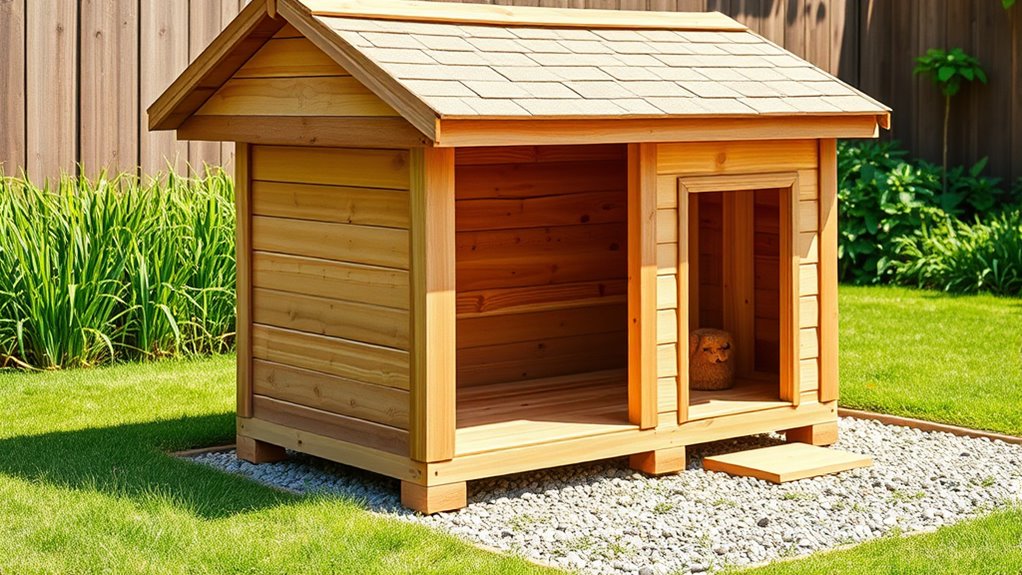
Start by selecting level ground to keep your dog house stable. Use durable materials that can withstand weather and wear, ensuring longevity. Make sure the site has proper drainage so water doesn’t pool around the foundation, preventing damage over time. Incorporate weather-resistant materials to further protect your shelter from the elements. Additionally, consider adding a drainage system around the foundation to enhance water runoff and reduce erosion. Ensuring proper ventilation can also help prevent moisture buildup and prolong the life of the shelter. Incorporating insulation can also help regulate temperature and keep your dog comfortable in various weather conditions.
Choose Level Ground
Choosing a level ground is essential for creating a stable and durable dog house. A flat terrain ensures your shelter remains steady and prevents future issues like shifting or tilting. To find the best spot, consider these factors:
- Check the ground level to avoid slopes that could compromise stability.
- Select a flat terrain to provide an even foundation.
- Clear away debris, rocks, or roots that can cause unevenness.
- Ensure proper drainage by choosing a spot where water naturally flows away.
- Incorporate automation’s role in business intelligence to monitor and maintain the foundation’s stability over time. Additionally, evaluating chimney cleaning and inspection can help ensure your outdoor space remains safe and well-maintained, preventing potential hazards.
Use Durable Materials
Using durable materials when building your dog house guarantees a solid foundation that can withstand weather and daily wear. Opt for sustainable materials like cedar or recycled wood to ensure longevity and eco-friendliness. Incorporate sturdy siding and roofing to protect your pup from rain and wind. Consider adding decorative accents made from weather-resistant materials to personalize the shelter without compromising durability. Visualize the foundation with this simple table:
| Material | Benefits |
|---|---|
| Reclaimed Wood | Eco-friendly, strong, weather-resistant |
| Cedar | Naturally resistant to decay |
| Composite Panels | Low maintenance, durable |
| Metal Roofing | Long-lasting, weatherproof |
| Decorative Accents | Enhance appearance, withstand elements |
Choosing the right materials creates a stable, attractive dog house that lasts. Additionally, selecting weather-resistant materials can further enhance the shelter’s durability over time.
Ensure Proper Drainage
To guarantee your dog house remains stable and comfortable, proper drainage is essential. You need to manage rain runoff effectively by creating a drainage slope away from the structure. This prevents water from pooling around the base, which could cause instability or rot. Focus on these key steps:
- Choose a Level Surface: Ensure the ground is flat but slightly tilted away from the entrance.
- Create a Drainage Slope: Aim for a slope of about 2-3% to direct water away.
- Use Gravel or Pavers: Place a layer underneath to improve drainage and stability.
- Elevate the Base: Raise the foundation slightly above ground level to prevent water intrusion.
- Consider Water Management techniques to further protect your dog’s shelter from rain runoff and ensure long-lasting stability. Additionally, incorporating proper drainage methods can help prevent water accumulation and extend the lifespan of your dog house.
These steps help keep rain runoff away, protecting your dog’s shelter and ensuring long-lasting stability.
Building the Walls and Roof
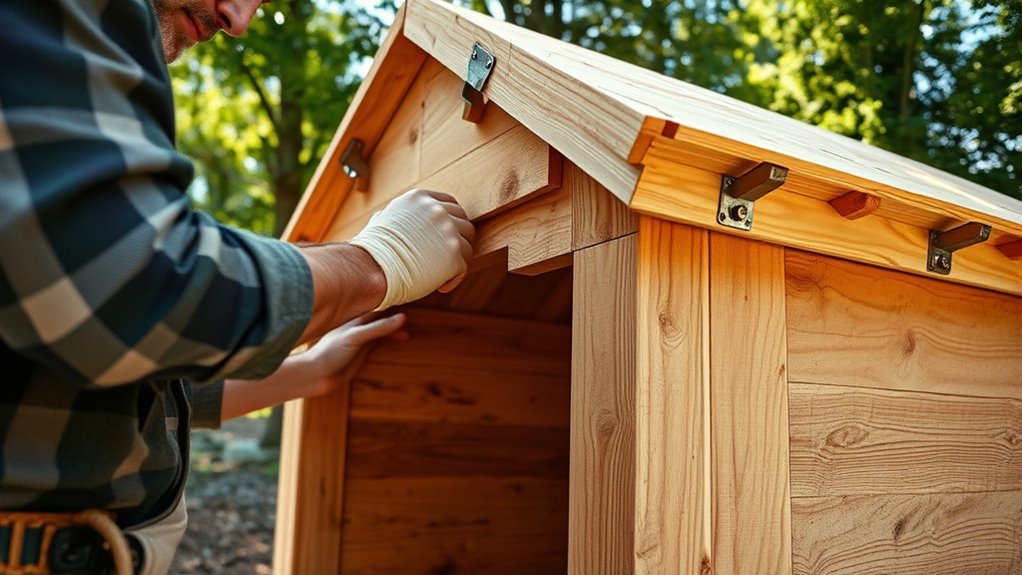
Have you ever wondered how to create sturdy, weather-resistant walls and a roof for your dog house? Start by selecting durable, waterproof materials like treated plywood or cedar. When building the walls, think carefully about door placement; positioning the door lower and centered helps keep out rain and wind. For ventilation options, leave small gaps near the top of the walls or install adjustable vents to ensure good airflow without letting in drafts. Use sturdy screws and weatherproof sealant to secure joints and prevent leaks. When constructing the roof, opt for an overhang that extends beyond the walls to protect against rain. Make sure the roof is sloped to allow water runoff, keeping your dog’s shelter dry and cozy. Additionally, incorporating performance cookies can help monitor how well the shelter design functions over time. Properly sealing the outdoor shelter enhances its durability and provides a more comfortable space for your dog. Recognizing the importance of weather-resistant materials can further improve the longevity of your DIY dog house.
Insulating the Dog House for Cold Weather
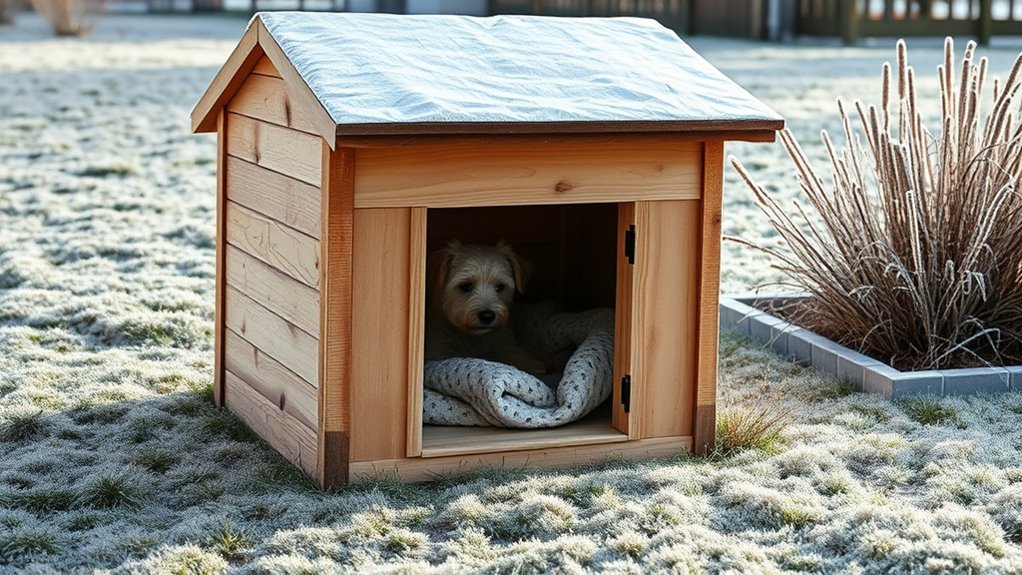
When temperatures drop, insulating your dog’s house becomes essential to keep your pet warm and comfortable. Proper thermal insulation helps retain heat, making the shelter cozy. To effectively insulate, consider these steps:
- Apply foam boards or reflective insulation to the interior walls to prevent heat loss. Using insulation materials that are suited for outdoor use can improve thermal efficiency.
- Use weatherstripping around the door to draft proofing gaps and blocks cold air.
- Add a layer of straw or bedding inside for extra warmth and insulation.
- Seal any cracks or gaps in the structure to improve thermal efficiency.
- Choosing energy-efficient insulation materials can further enhance heat retention and reduce heat loss. Additionally, understanding pollution and hydrogen fuel cells and their environmental benefits can inspire sustainable practices in outdoor shelter setups for your pet.
Adding a Door and Ventilation Features
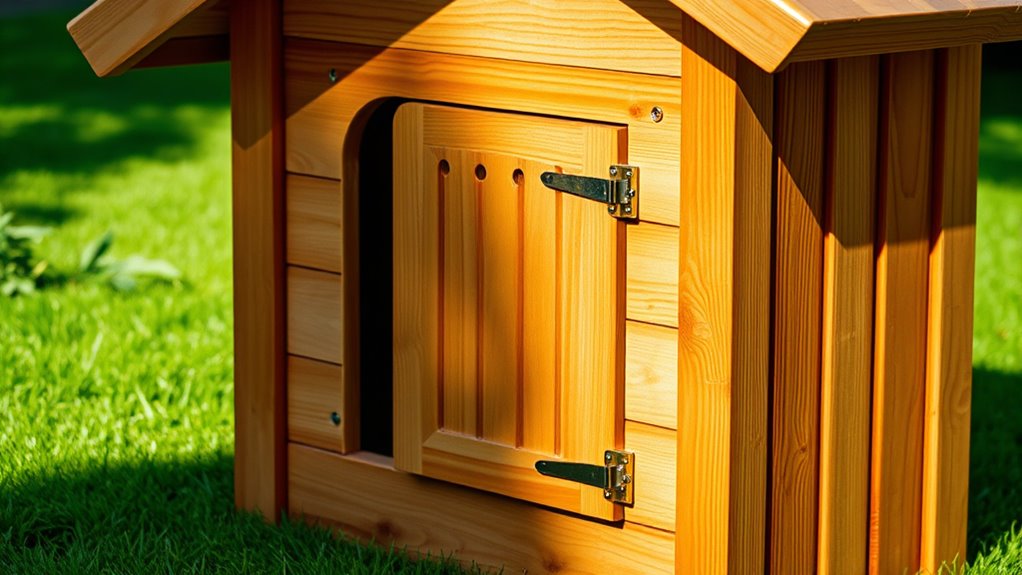
Choosing the right door placement guarantees your dog can easily enter and exit without drafts or obstructions. Incorporate effective ventilation strategies, like small vents or adjustable windows, to keep fresh air circulating. Properly combining these features helps create a comfortable, safe space for your furry friend. Additionally, ensuring proper airflow management is essential to prevent moisture buildup and maintain a healthy environment inside the dog house. Incorporating ventilation features can significantly improve air quality and reduce humidity levels, which is crucial for your pet’s comfort. Regularly inspecting and cleaning these ventilation openings helps sustain their effectiveness over time. Implementing proper insulation can further enhance the dog house’s comfort by maintaining a stable temperature inside.
Proper Door Placement
To guarantee your dog house is comfortable and functional, proper door placement is essential. The key factors include selecting the right entry height and positioning the door correctly. Consider these points:
- Entry height should be level with your dog’s shoulders for easy access.
- Position the door away from prevailing wind directions to reduce drafts.
- Place the door on the windward side for better protection against weather.
- Ensure sufficient clearance around the door for your dog to move comfortably without obstruction.
These steps help maintain warmth, prevent water intrusion, and improve your dog’s comfort. Proper door placement not only maximizes protection but also makes your dog house more inviting and functional for your pet.
Effective Ventilation Strategies
Adding a door and ventilation features is essential for guaranteeing fresh air circulation inside your dog house. Proper vent placement allows natural airflow, helping to keep the interior cool and dry. Position vents near the roof’s peak to promote hot air escape, while placing them lower encourages cooler air to enter. This setup creates a continuous airflow, reducing humidity and preventing condensation. Consider adding small, adjustable vents or screened openings to control airflow during different weather conditions. Avoid blocking existing openings or sealing vents too tightly, as this can trap stale air. By carefully designing vent placement, you ensure your dog stays comfortable, especially during hot or humid days, and promote overall health and well-being.
Painting or Sealing for Weather Resistance
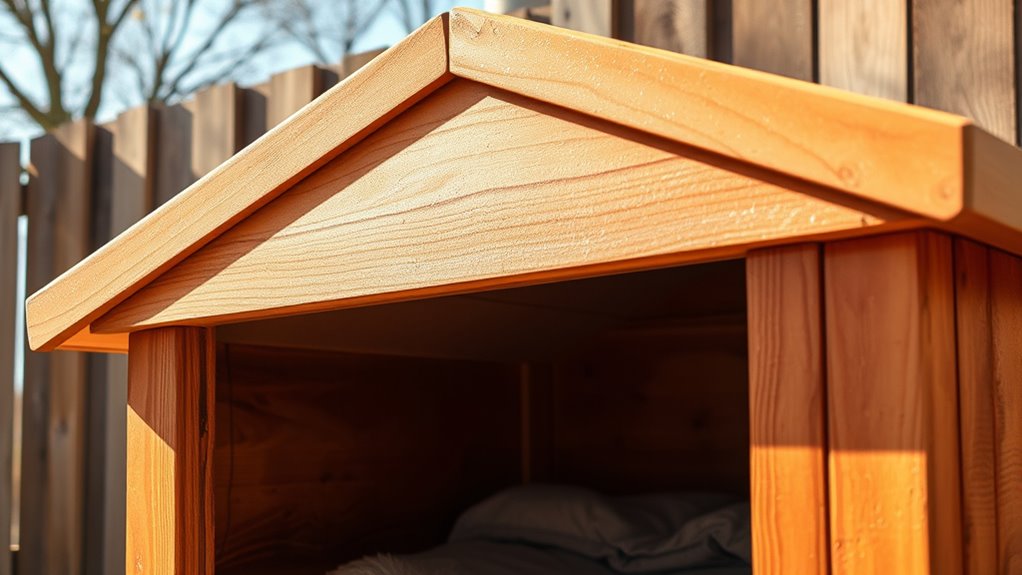
Applying a weather-resistant paint or sealant is essential to protect your dog house from rain, snow, and moisture. A quality weatherproof coating creates a barrier that prevents water infiltration and prolongs the structure’s life. When applying sealant, focus on these key steps:
- Clean the surface thoroughly to guarantee proper adhesion.
- Choose a high-quality sealant suited for outdoor use.
- Apply the sealant evenly, covering all joints and seams.
- Allow sufficient drying time before exposing the dog house to weather.
Elevating the Structure for Durability
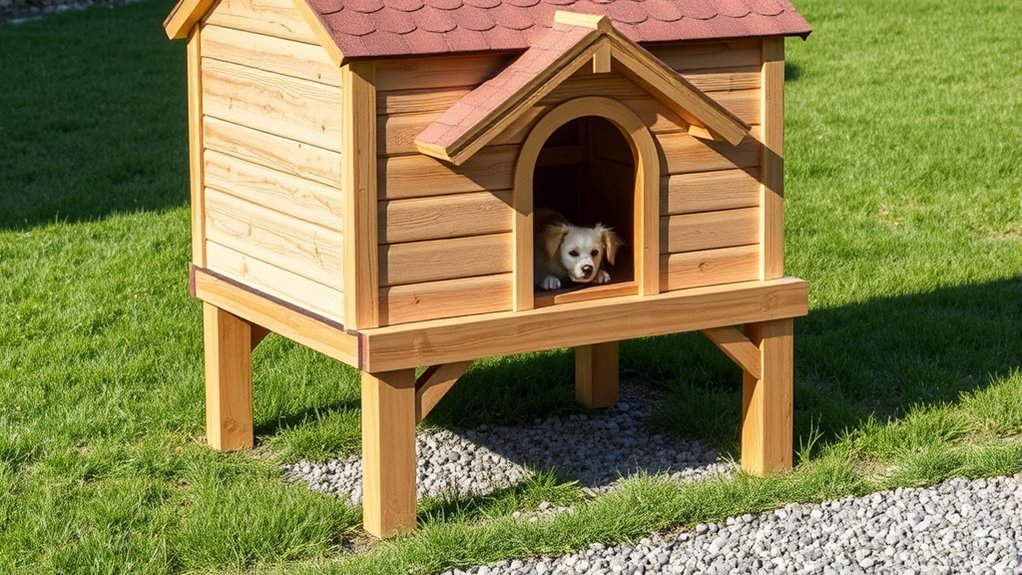
Raising your dog house off the ground considerably enhances its durability by preventing moisture damage and reducing the risk of pests. A raised platform creates proper footing elevation, ensuring water doesn’t pool around the base and cause rot. Use sturdy materials, like pressure-treated wood or concrete blocks, to build a solid footing. This elevation also improves airflow beneath the structure, helping it stay dry and cool. When designing your raised platform, make sure it’s level and stable to support the entire weight of the dog house. Proper footing elevation not only prolongs the lifespan of your shelter but also keeps your furry friend comfortable and safe. Investing in a well-elevated foundation is a smart step toward a durable, weather-resistant outdoor dog house.
Final Touches and Maintenance Tips

Once you’ve completed building and elevating your dog house, paying attention to final touches and ongoing maintenance guarantees it stays in great shape. Regular cleaning routines prevent dirt buildup and keep your dog’s shelter hygienic. Consider these key steps:
- Schedule weekly cleanings to remove debris and sanitize surfaces.
- Add decorative accents like paint or outdoor-safe ornaments to personalize the space.
- Inspect for damage or wear, repairing cracks or loose parts promptly.
- Elevate and cover the base to prevent moisture and pests from entering.
Frequently Asked Questions
How Can I Ensure My Dog Feels Safe and Comfortable Inside?
To guarantee your dog feels safe and comfortable inside, focus on proper dog bed placement in a quiet, cozy corner away from drafts. Add calming accessories like a soft blanket or calming sprays to reduce stress. Keep the space clean and avoid loud noises. Your dog will feel secure and relaxed when you create a peaceful environment, making it easier for them to settle in and enjoy their outdoor shelter.
What Are the Best Weatherproofing Options for Outdoor Dog Houses?
Imagine your dog’s house as a sturdy ship, weatherproofed to face any storm. Treat the wood with waterproof sealants and exterior paint to keep moisture out. Add insulating materials like foam or straw to shield against cold and heat. These layers create a cozy haven, protecting your furry friend from rain, snow, and sun. With proper weatherproofing, you guarantee your dog’s outdoor shelter remains safe and comfortable year-round.
How Do I Customize the Dog House for Different Dog Breeds?
To customize the dog house for different breeds, you should focus on breed-specific insulation to keep them comfortable in varying temperatures, and choose breed-appropriate flooring for their size and activity level. For example, larger breeds may need thicker insulation and sturdy flooring, while smaller breeds benefit from softer bedding and warmer insulation. Adjust the size, ventilation, and entry points to suit their unique needs, ensuring your dog feels cozy and secure.
What Safety Precautions Should I Take During Construction?
Think of construction safety like charting a labyrinth—careful steps keep you safe. During construction, you should always wear protective gear, like gloves and goggles, to prevent injuries. Keep tools sharp, clean, and use them according to instructions, practicing proper tool precautions. Maintain a clean workspace to avoid accidents. By prioritizing construction safety, you’ll create a cozy dog house without risking harm, ensuring a safe and successful project.
How Often Should I Clean and Maintain the Dog House?
You should clean your dog house at least once a month to keep it fresh and odor-free. Follow a regular cleaning schedule, including removing bedding and scrubbing surfaces with mild soap and water. Maintenance tips also involve checking for damages, ensuring proper ventilation, and replacing bedding as needed. Doing this helps keep your pet comfortable, healthy, and safe while extending the life of the shelter.
Conclusion
Building your own dog house is like crafting a cozy nest where your furry friend feels safe and loved. Just like a sturdy tree withstands storms, a well-built shelter keeps your dog comfortable year-round. With patience and care, you create more than just a shelter—you build a haven. When you see your pup happily snuggled inside, you’ll know all the effort was worth it, turning your DIY project into a lasting bond.

